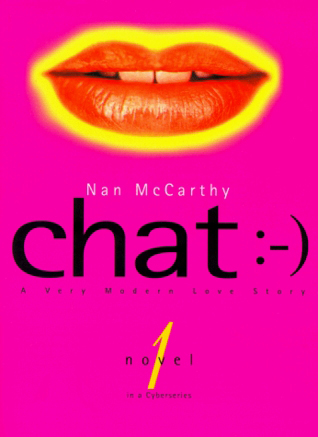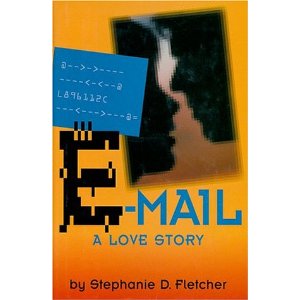WriteSites: the email liaison as novel
Esther Milne
 You’re the cutest thing that I ever did see/really luv your peaches wanna shake your tree/Lovey dovey, lovey dovey, lovey dovey all the time/Oooey baby I sure show you a good time.
You’re the cutest thing that I ever did see/really luv your peaches wanna shake your tree/Lovey dovey, lovey dovey, lovey dovey all the time/Oooey baby I sure show you a good time.
Er, sorry about that. Don’t know what’s wrong with me today. Must be that email I just got from Peaches. I mean seriously, do you know anyone called Peaches? What about Buck, heard from him lately? Unlikely as it may sound, this nomenclature resonates with literary gravitas and the portent of tele-communications historiography. Stay with me.
Since McLuhan’s observation that new technologies are always inscribed by earlier modes and practices, media theory has insisted that its forms do not arrive unheralded. Cybercultural genealogy is awash with theorists peering further and further into the past. Commentators such as Margaret Wertheim (The Pearly Gates of Cyberspace: A history of space from Dante to the Internet, Doubleday, Sydney, 1999) argue that the idea of cyberspace is unthinkable without critiquing the changing metaphysical and scientific conceptions of space, and writers like Janet Abbate (Inventing the Internet, MIT Press, Cambridge Massachusetts, 1999) or Katie Hafner and Matthew Lyon (Where Wizards Stay Up Late: the Origins of the Internet, Touchstone, New York 1996) dispute the conventional myth that the internet’s origins are limited to American military scenarios. But as these areas of inquiry are comprehensively covered, others remain somewhat under researched.
Electronic mail, while implicit in the cited studies, seems not to receive the same sort of sustained critique. One way to redress the gap is to historicise the email novel. This emerging genre can be traced to 18th century British and European cultures where an increasingly literate population and the technological advancements of the postal service give rise to the epistolary novel. Works such as Les Liaisons Dangereuses by Choderlos de Laclos, Jean Jacques Rousseau’s La Nouvelle Heloise or Samuel Richardson’s Pamela are narratives constructed from letters whose formal and thematic properties presage certain contemporary literary genres.
How to spot an email novel? Well, the title must include technological form, literary vehicle and a signifier of lerv. Cyber word, colon: love word. Consider, Chat: a cybernovel (Nan McCarthy, Peachpit Press, Berkeley 1996); Virtual Love: a novel (Simon & Schuster, New York 1994.); Safe Sex: An e-mail romance (Linda Burgess & Stephen Stratford, Godwit Publishing Limited, Auckland 1997); and Email: a love story (Stephanie D Fletcher, Headline Book Publishing, London 1996) and you begin to see the point. To a large extent, email novels function according to the generic principles of epistolary fiction. The exchanges are presented chronologically, framed by dates, salutations and signatures. In both genres there is a strong emphasis on the body’s absence: correspondents are separated spatially and temporally and the missive is used as a means to negotiate this gap. And both narratives are informed by themes of love, seduction, adultery and betrayal. More specifically, one might draw parallels between 2 of the texts by comparing their articulations of subjectivity formation.
 Both the 18th century epistolary novel Les Liaisons Dangereuses and Fletcher’s E-Mail: A Love Story, for example, wrestle with the problem of women’s sexuality in terms of the transgression of institutional ideology. Laclos’ Mme de Merteuil is exiled because she dares to usurp the masculine privilege of the sexual aggressor and Katherine Simmons, the protagonist of E-Mail: A Love Story, is reformed at the novel’s end by her return to legitimate sexual acts defined by the marital contract. The configuration of identity seems to concern both genres since the epistle form permits an opportunity to explore or radicalise questions of subject formation. Mme de Merteuil explicitly refers to her propensity for dissembling and reinventing herself and the correspondents in Fletcher’s text regularly discuss the advantages of and need for the use of pseudonyms (hence “Peaches” and “Your cowboy, Buck”).
Both the 18th century epistolary novel Les Liaisons Dangereuses and Fletcher’s E-Mail: A Love Story, for example, wrestle with the problem of women’s sexuality in terms of the transgression of institutional ideology. Laclos’ Mme de Merteuil is exiled because she dares to usurp the masculine privilege of the sexual aggressor and Katherine Simmons, the protagonist of E-Mail: A Love Story, is reformed at the novel’s end by her return to legitimate sexual acts defined by the marital contract. The configuration of identity seems to concern both genres since the epistle form permits an opportunity to explore or radicalise questions of subject formation. Mme de Merteuil explicitly refers to her propensity for dissembling and reinventing herself and the correspondents in Fletcher’s text regularly discuss the advantages of and need for the use of pseudonyms (hence “Peaches” and “Your cowboy, Buck”).
While the 2 genres share some formal and thematic elements, there are of course points of departure. Part of the problem is to do with the awkward mimetic situation of email novels because they use the conventions of print technology to describe, represent and invoke the tropes of electronic communication. Email novels quote the digital sign. In place of the usual epistolary preface, E-mail a love story begins with 3 pages that reproduce the instructions for a fictitious computer based communications system called ‘Luxnet’ (based presumably on services such as America On Line or CompuServe): “to learn more about electronic mail simply click your mouse over the mail icon on the screen.” Needless to say, there is no mouse, icon or screen.
This mimetic fissure is tackled by Carl Steadman in a fascinating internet based project called Two Solitudes, an e-mail romance (http://www.freedonia.com/ – link expired). Steadman (one of the co-founders of Suck) has written a novel dictated by the email interface rather than the print environment. One ‘subscribes’ to the story using similar protocols to Listserv discussion groups. What follows is a series of emails purported to be copies of the correspondence from the exchanges of 2 people of indeterminate gender (Lane and Dana) but amorous intent. The technological verisimilitude is so successful that it is quite possible to forget one is reading fake mail. It is a compelling literary experiment clearly informed by the epistolary theory of Jacques Derrida’s The Post Card (1987).
Where Steadman’s theoretically astute email fiction is overtly indebted to an epistolary past (and all that that implies about the author/reader dynamic of tele-communication), the email novels must also be seen within their literary heritage. Just because someone in Email: A Love Story signs his missives from a ‘cyber Romeo’, doesn’t mean he can’t grow up to be John Malkovich.
RealTime issue #38 Aug-Sept 2000 pg. 27






